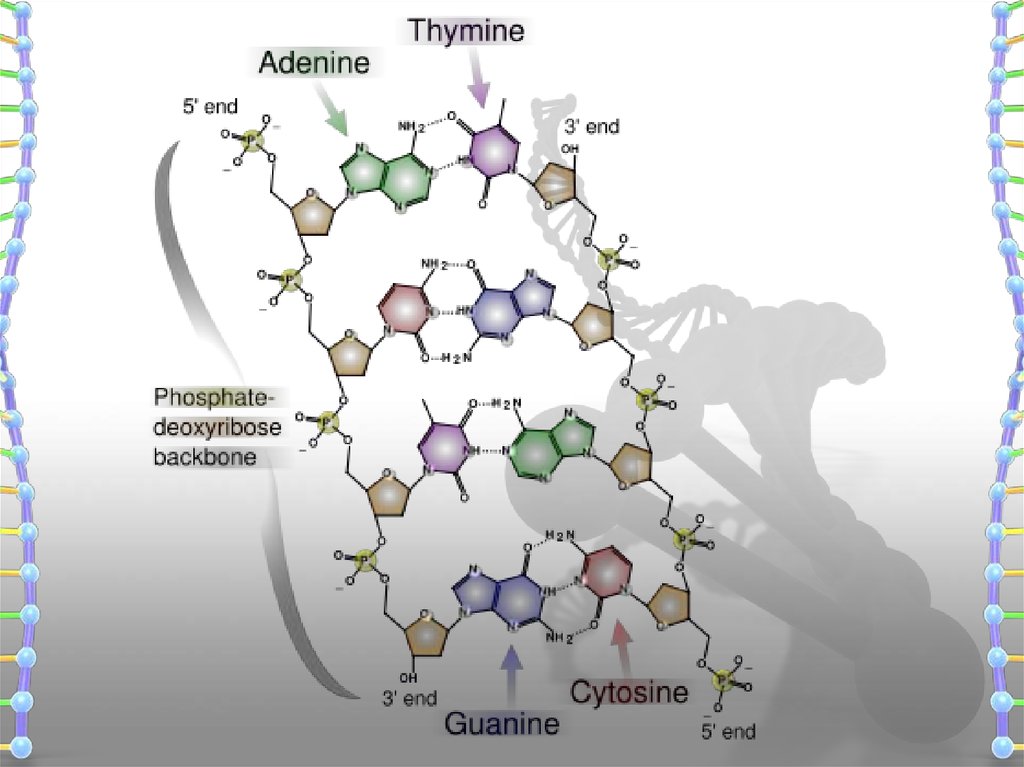Похожие презентации:
Structure Of DNA & RNA
1. Structure Of DNA & RNA
Structure Of DNA & RNABy Asan Asel
Zhxm-611f
2.
DNA3.
DNADeoxyribonucleic acid
DNA - a polymer of deoxyribonucleotides.
Usually double stranded.
And have double-helix structure.
found in chromosomes, mitochondria
and chloroplasts.
It acts as the genetic material in most of
the organisms.
Carries the genetic information
4.
A Few Key Events Led to theDiscovery of the Structure of DNA
DNA as an acidic substance present
in nucleus was first identified by
Friedrich Meischer in 1868.
He named it as ‘Nuclein’.
Friedrich Meischer
5.
In1953 , James Watson and Francis Crick,
described a very simple but famous Double
Helix model for the structure of DNA.
6.
FRANCIS CRICK AND JAMES WATSON7.
The scientific framework for theirbreakthrough was provided by other
scientists including
Linus Pauling
Rosalind Franklin and Maurice Wilkins
Erwin Chargaff
8.
Rosalind FranklinShe worked in same laboratory as Maurice Wilkins.
She study X-ray diffraction to study wet fibers of DNA.
X-ray diffraction
of wet DNA fibers
The diffraction pattern is
interpreted
(using
mathematical
theory)
This can ultimately
provide
information concerning the structure
of the molecule
X Ray
Crystallography
Rosalind
Franklin’s photo
9.
She made marked advances in X-raydiffraction techniques with DNA
The diffraction pattern she obtained
suggested several structural features of DNA
Helical
More than one strand
10 base pairs per complete turn
10.
Rosalind FranklinMaurice Wilkins
11. DNA Structure
DNA structure is often divided into fourdifferent levels primary, secondary,
tertiary and quaternary.
DNA
has three main components
1. Deoxyribose (a pentose sugar)
2. Base (there are four different ones)
3. Phosphate
12.
A, G, C or TO
Base
O P
O–
O CH2
5′
4′
Phosphate
H
H
3′
A, G, C or U
O
Base
O P
O
H
1′
H
2′
OH
H
Deoxyribose
DNA Nucleotide
O CH2
O–
5′
4′
Phosphate
H
H
3′
O
H
1′
H
2′
OH
OH
Ribose
RNA Nucleotide
13. The Nitrogenous Bases
THEY ARE DIVIDED INTO TWO GROUPSPyrimidines and purines
PYRIMIDINES (MADE OF ONE 6 MEMBER RING)
Thymine
Cytosine
PURINES (MADE OF A 6 MEMBER RING, FUSED
TO A 5 MEMBER RING)
Adenine
Guanine
THE RINGS ARE NOT ONLY MADE OF CARBON
14. Nitrogenous bases of DNA & RNA
Nitrogenous bases of DNA & RNA15. Nucleotide Structure
Nucleotidesare formed by the condensation of a
sugar, phosphate and one of the 4 bases
The following illustration represents one nucleotide
Phosphate
Nitrogenous
Bases
Deoxyribose
16.
OO P
O–
Base
O
CH2
5′
4′
Phosphate
H
H
3′
O
1′
H
H
2′
OH
H
Deoxyribose
DNA nucleotide
17.
Base + sugar nucleosideExample
Adenine + ribose = Adenosine
Adenine + deoxyribose = Deoxyadenosine
Base + sugar + phosphate(s) nucleotide
Example
Deoxyadenosine monophosphate (dAMP)
Deoxyadenosine diphosphate (dADP)
Deoxyadenosine triphosphate (dATP)
18.
Deoxyadenosine triphosphateDoxyadenosine diphosphate
Deoxyadenosine monophosphate
Deoxyadenosine
Adenine
Phosphoester bond
NH2
N
N
H
O
–O
P
O–
O
O
P
O
O
O–
P
N
O
O–
CH2
5′
4′
H
H
Phosphate groups
Phosphates are
attached here
3
N
O
H
2′
HO
H
Deoxyribose
1′
H
Base always
attached here
19.
Nucleotides are linked together by covalent bonds calledphosphodiester linkage.
A chemical bond that
involves sharing a pair of
electrons between atoms in
a molecule.
P
5
1
4
Base
Sugar
3
2
P
5
1
4
Sugar
3
2
Base
20.
BackboneBases
O
5′
CH3
N
Thymine (T)
H
–
O
O
P
O
–
O
CH2
5′
4′
H
H
O
N
O
1′
H
2′
H
H
3′
NH2
N
Phosphodiester
linkage
N
Adenine (A)
H
N
O
O
P
O–
O
CH2
5′
4′
H
H
O
1′
H
2′
H
H
3′
NH2
H
N
H
O
O
N
P
O
–
O
CH2
5′
4′
H
H
Cytosine (C)
O
N
O
1′
H
2′
H
H
3′
Guanine (G)
O
H
N
N
H
N
O
Single
nucleotide
O
P
O
CH2
5′
O
4′
H
Phosphate H
–
3′
OH
3′
O
1′
H
2′
H
H
Sugar (deoxyribose)
N
NH2
21.
DNA Double Helix & Hydrogen bondingSalient features of the Double-helix structure of DNA:
It is made of two polynucleotide chains, where the backbone
is constituted by sugar-phosphate, and the bases project inside.
The two chains have anti- parallel polarity. It means, if one chain
has the polarity 5’ 3’, the other has 3’ 5’.
5’
3’
G
C
T
A
C
G
A
T
3’
5’
22.
23.
DNA Double Helix & Hydrogen bondingThe bases in two strands are paired through hydrogen bond (H-bonds)
forming base pairs (bp). Adenine forms two hydrogen bonds with
Thymine from opposite strand and vice-versa. Similarly, Guanine is
bonded with Cytosine with three H-bonds.
Based on the observation of Erwin Chargaff that for a double stranded
DNA, the ratios between Adenine and Thymine; and Guanine and
Cytosine are constant and equals one.
Hydrogen bond:-A chemical bond consisting of a hydrogen atom
between two electronegative atoms (e.g., oxygen or nitrogen) with
one side be a covalent bond and the other being an ionic bond.
3 Hydrogen bonds
2 Hydrogen bonds























 Биология
Биология








